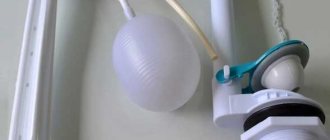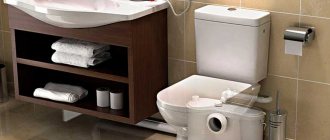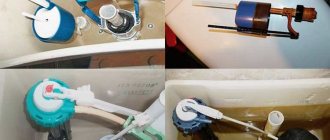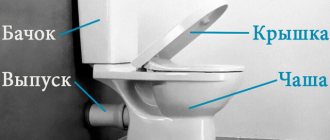When the toilet tank does not hold water, this is an unpleasant breakdown, since water consumption increases, which is associated with additional costs, and constant unpleasant noise occurs. Therefore, when the first signs of this malfunction occur, it must be eliminated immediately. Below we will look at how to do this yourself.
Toilet cistern
How to check the serviceability of the tank
Normally, the flushing process goes like this. When you press the drain key or button (in older models it may be a lever on a chain), the drain valve opens. Water flows under pressure into the bowl and cleans it. The flow of fluid is most often in one burst, short-term. But sometimes it can be longer.
After resetting, the valve closes automatically, less often after pressing the button again. In any case, after closing it there should be no leakage in the bowl. If this is not the case, you need to test the tank to ensure it is working properly. We list the signs indicating possible problems.
Signs of leakage
- Lime deposits or rust stains have appeared in the bowl near the drain.
- Periodically appearing or even constant murmur.
- Weak and prolonged flushing. It doesn't look like a strong salvo release.
- The toilet wall located closer to the tank is wet. Moisture appears even when the plumbing fixtures have not been used for a long time.
- Moisture on the tank and pipes.
Drops of condensate appearing on the equipment indicate that cold liquid is constantly circulating in the pipeline. Whereas with normally operating equipment this should not happen. If such signs appear, technicians recommend first cleaning the inside of the tank. Sometimes the cause is dirt accumulated in it.
To do this, close the shut-off valve, empty the container and remove the fittings from it. Thoroughly clean off silt deposits and limescale deposits and reassemble the device. If the problem persists, look for another solution.
Instagram master_trub_
- Plumbing equipment
Do-it-yourself toilet installation: useful instructions for different models
Looking for a fault: elimination method
Before you decide to start troubleshooting the problem in the drain tank yourself, you need to make sure that is to blame .
Quite often, a leak is detected between the toilet bowl and the cistern . The float has nothing to do with this case. The problem here is the abrasion of the o-ring, which is located between the bowl and the tank:
Fixing this problem is simple : you just need to install a new gasket .
It is also possible for water to leak onto the floor next to the toilet. Here, too, it 's not about the float. This occurs due to water seeping into cracks in the toilet tank and bowl or due to damage to the fittings connecting the pipes.
If the tank is incompletely emptied or consumption when it pours into the toilet bowl in a continuous stream, less often in a trickle, then the problem lies in incorrect adjustment of the float.
What to do if water is constantly flowing in the toilet
The design of the fittings of modern models differs from outdated systems with a rubber float bulb. New devices are equipped with two units: drain and float. A key or button activates the drain; it is carried out by the drain mechanism. After the container is empty, the water supply starts. It is already regulated by a float system.
Module design may vary depending on models. Their features can be found in the technical documentation or when disassembling the equipment. If the toilet tank is leaking, you will still have to disassemble it. It is important to remember that this can only be done with the shut-off valve on the supply line or on the riser entering the apartment closed. The reservoir must be emptied before doing this.
The disassembly scheme is simple. First, the drain button is unscrewed, then the lid is removed. After this it is easy to get the parts. The elements of the units are made of plastic and are fixed with bolts and plastic or rubber seals. Parts from different manufacturers are often interchangeable, so it is not difficult to find a replacement for a worn one. First you need to measure the worn-out product or bring it to the store.
Instagram vladimir_santex_churicov
Let's look at the main reasons why the toilet cistern leaks and how to fix the problem.
The seal has deteriorated
This is a ring made of rubber or plastic. It is located at the outlet of the water jet. It retains sediment, fragments of mineral deposits and other contaminants. Therefore, there are two reasons for such a breakdown: the part is either too dirty or worn out. In the second case, it becomes thinner, frayed or deformed. Whatever the reason, the water will flow constantly. The seal needs to be replaced or cleaned. The procedure is carried out according to this scheme.
- Remove the lid of the container. We dismantle the mechanism. To do this, turn the module to the left half a turn until it clicks.
- Prepare a cleaning solution with any mild soap. Cleaning the parts.
- We carefully inspect the seal. If there are cracks or deformation, replace it with a new one.
- We put the module in place.
Instagram vse_vidi_santexniki
- Plumbing equipment
How to install corrugation on a toilet: step-by-step instructions
Float mechanism failure
There may be two options here. The first is the loss of tightness of the float. In this case, it does not rise to the surface when the volume of liquid in the container increases. This is immediately noticeable upon visual inspection. When the tank is filled, the overflow system is activated, water flows from the tank into the toilet without interruption. The second option is a breakdown of the mechanism fastening. In any case, the module needs to be replaced. It's done like this.
- We carry out diagnostics. To do this, without emptying the tank, remove the lid. Press the drain key. Let's see how the float works.
- We dismantle the tank. Close the shut-off valve and activate the flush button. We unscrew the hoses and fasteners suitable for the container. Carefully remove the tank from the shelf-stand. It is heavy enough that it cannot be dropped.
- Remove the float. It must be carefully unscrewed and replaced with a new one. We place the unit in its seat and securely fix it with plastic fasteners.
- We place the tank on the toilet shelf and secure it with mounting pins. We connect the flexible liner.
- All that remains is to install the lid, open the stop valve and do a test flush.
Instagram mastervdomeufa
Short-term leakage after draining
Sometimes the tank leaks while it is being filled with new water. The cause may be a misalignment of the drain module. It's noticeable right away. The drain key begins to jam, sometimes it simply falls into the mounting hole. In this case, you need to dismantle the cover and remove the assembly. Most likely, he moved out a little from his seat. We need to place it correctly.
It happens that the water flow brings quite large particles of mineral sediment or solid contaminants. They get under the seal ring and break its tightness. In an empty tank, the pressure on the valve is low, and it allows liquid to pass through. As soon as the tank is full, the pressure increases and the stream is pinched. The problem can be resolved by thoroughly cleaning the parts.
It is possible that one of the valve components broke or was initially defective. Only replacement will help here. The unit is dismantled. Worn out elements are replaced if possible. If not, a new module is purchased. After repair or replacement, the mechanism is installed in the tank. A test run of water is being carried out.
Instagram macstep_vit
Cracks on the tank
Sometimes the cause of a leak lies in a violation of the integrity of the tank. Let's look at how to eliminate leakage if the toilet cistern is cracked and leaking. You must understand that you can fix the problem only temporarily. The best solution is to replace the plumbing, and this will still have to be done. As a temporary measure, minor repairs can be carried out. They do it like this.
- We dismantle the tank. To do this, empty it, remove the cover, and remove the fittings. We unscrew the fasteners and liner, remove the container from the toilet shelf.
- Dry the outer and inner surface of the tank well.
- Carefully seal all cracks with a suitable sealant. We act strictly according to the manufacturer's instructions. Let the material harden.
- We put the container in place and secure it with bolts. We connect the water supply and install the fittings.
It is unknown how long the equipment will work after repair. Therefore, it is advisable to plan to replace your plumbing fixtures in the near future.
Instagram mastervdomeufa
- Plumbing equipment
How to choose and correctly install a hygienic shower for a toilet
If the float valve is clogged
Float Valve Operation
Another very common cause of overflow is a clogged float valve. First you need to understand the principle of its operation. So, when enough water is collected in the tank, the float floats up and moves the plug with its special lever. This plug blocks the hole through which water flows.
It is rare to encounter a situation where an overflow in the toilet cistern is simply not provided. Then you need to do the following:
- Turn off the water and let the tank dry completely;
- After this, unscrew the special connection and disassemble the valve that is responsible for the water supply;
- Next, you need to remove the plug, use pliers to straighten the so-called cotter pin and carefully remove it from the system;
- Next, you need to pull out the holder of our part, that is, the float, from the valve body itself, while you need to hold the body itself well. After which you will be able to notice how easily the so-called locking lever will be pulled out and the rubber gasket will fall out;
- Next you need to clean the hole well with a long wire;
That's it, the work is completed. Now you need to assemble everything, but we must not forget that the gasket should be changed. This repair is simple, the main thing is to do everything correctly.
The main components and mechanism of operation of the toilet cistern
Modern toilets may differ in the filling of the tank, but the main parts and the principle of their operation are in most cases similar. The design of almost all tanks is not complete without the following components.
- Locking mechanism. This is a tap that automatically turns off the water supply when the tank is filled. The degree of fullness of the tank, which is a signal for the shut-off valve to operate, is the responsibility of the float, which is constantly kept on the surface of the water.
- Reset system. This mechanism is a valve that blocks the drain hole. The valve is controlled using a button or lever. Modern models of flush cisterns are equipped with one or two flush buttons.
- Overflow system. During an unexpected breakdown of the locking mechanism, it ensures that water is drained into the toilet.
Often new models of toilets with a tank are mounted to the water supply with a bottom connection. The main distinguishing feature of such a tank is the presence of a diaphragm valve. Under the influence of water pressure, it opens slightly and lets water inside.
With optimal water filling, the float exerts force on the piston rod, which gradually closes the central valve. When the correct water level is established, the valve is completely closed.
Installation of flush fittings
The body of the tank is made of sanitary ware or special plastic. Unlike traditional cast iron, these materials do not corrode and can last a very long time. Any toilet flush mechanism consists of three basic components:
- An inlet valve
connected to a float. It is responsible for controlling the water level in the tank during collection. As soon as the float rises to the desired height, the valve stops the flow of liquid. - Locking mechanism
ensuring water drainage. In Soviet plumbing, a lever or chain was installed for this; they were connected to a bulb placed at the bottom of the tank. New models have a push-button mechanism, and sealing gaskets are provided to protect against water leakage. - Overflow system
. Its purpose is to protect against flooding of the room if for some reason the inlet valve stops working. The shut-off valve ensures that water drains into the bowl if its level exceeds a certain level.
Related article: Toilet flusher
To ensure timely operation of the intake valve, several types of floats are used. Modern toilet models use a hollow rubber float with air inside. Old plumbing used a glass-shaped plastic float. Thanks to the air filling, it begins to float as soon as the water reaches a certain level.
If there is a leak in the tank, do not panic. Most problems can be resolved on your own. To determine the cause of the problem, remove the toilet tank lid and examine the condition of the mechanism.











